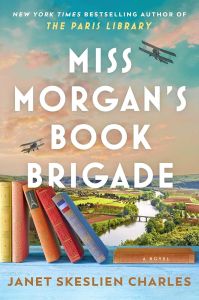France, 1918: the Great War is almost over, but it doesn’t feel like it for civilians close to the lines, where the threat of a German resurgence hangs as close to the battered ground as the dust from the constant artillery. Two American socialites, Anne Morgan and Anne Murray Dike, have formed an organization of women to go to France and offer aid and assistance to suffering French civilians — people whose villages are razed, whose lives were destroyed. Among their number is Jessie “Kit” Carson, a librarian who intends to help establish children’s libraries in rural France. Her story is discovered over sixty years later by another librarian, Wendy Peterson — who finds articles about her in the NYC’s archives and is immediately obsessed, finding in the “CARDs” — the volunteer women — her inspiration to write. Miss Morgan’s Book Brigade tells each of their stories in turn, with alternating chapters. Through Jessie, we explore French civilian life amid the war, and find people struggling: they’re tired of death and war, haunted by their losses — and Jessie does her best to offer them reasons for hope through literature. Wendy’s journey involves archival detective work, where we learn about the CARDS and the two Annes in a more direct way. The result is enjoyable, but becomes all the more impressive after the revelation that Jessie is real and she transformed French library science.
Where this most succeeds is sharing the story of the two historic Annes and the real organization they formed together. as well as revealing how much of the Great War still marks France. I didn’t realize there are still exclusionary zones where human activity is forbidden due to the amount of poisonous or unxploded ordinance still buried there. Kit’s story is easily the better of the two threads in the book, as she works diligently to make a difference in the lives of those around her with literature, even in the midst of a war: through her we experience its final year, which was not a slow die-down but just as harrowing as the opening year, as Germany launched a spring offensive that seriously challenged the Entente powers. Despite the setting, though, I couldn’t quite buy the historicity — it didn’t feel like I was in 1918: Jessie and Wendy both feel like the same character, a thoroughly modern Millie, albeit with more interest in romance on Wendy’s part. (Speaking of, there are some quick but awkward sex scenes in here. I don’t think they add anything.) Not helping is the fact that even though Jessie speaks French, most of the titles she recommends are Anglo-American, with the exception of a Dumas title.* Granted, they’re all great titles (Tom Sawyer, Anne of Avonlea), and yes, she’s writing for an English-speaking audience who are probably oblivious to the world of French literature, juvenile or otherwise — but it sapped historical immersion for me, as did mentions of bombing raids and the American airman, who is sometimes a pilot and sometimes a mechanic.
The arrival of the Spanish flu did begin to build some historic tension (slightly spoiled by the author trying to work in some painfully obvious corona connections), as does the librarian characters arguing about the open-stack system in which patrons could browse and borrow at will, instead of requesting a title from the catalog and waiting for a librarian to achieve it. (This was a culture shock for me in reading The Many Loves of Dobie Gillis, learning that the stacks were closed!) I love the central idea of one person finding connections to another across the decades: it looks like the author has played with that in at least one more of her books, and according to the epilogue it was the author’s research for that book that led to this one. There were some standouts here, like the young French girl Marcelle who doesn’t hesitate to correct her “betters” French, who Kit mentors, and she plays a prominent part in bringing the novel to a close with a wonderful finish, one that bumped this up in my estimation.
[*] My favorite moment is when a soldier slid a paperback copy of The Count of Monte Cristo in his shirt pocket. Have fun with that.
Related:
“The French Connection“, American Libraries
Brief Wiki article on Jessie


I’ve had a LONG interest in what exactly happened *after* the World Wars – especially the clean up of battlefields and the rebuilding of things. Considering the amount of ordinance used by all sides in both wars I’m not surprised that some areas in France are still ‘off-limits’ and that unexploded bombs and shells are still being found – including poison gas!! A lot of ours was just dumped in the Irish Sea and seismographs pick up occasional explosions on the seabed!!
It must have quite dangerous, for example, to be a farmer ploughing fields in northern France from 1919 onwards. Not to best way to come across an artillery shell – no matter what it contained!